
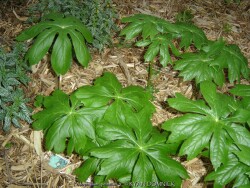
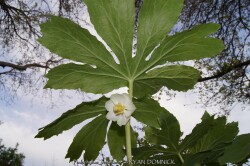
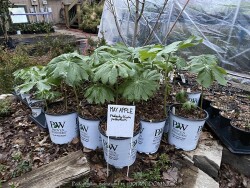
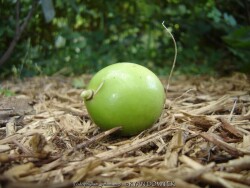

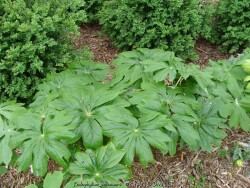
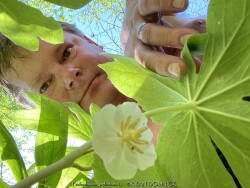
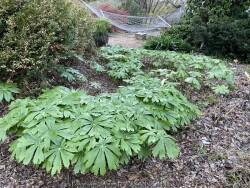
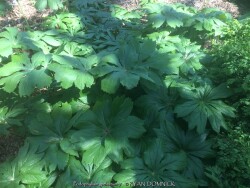
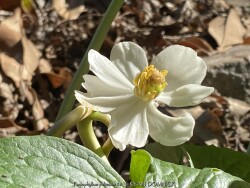

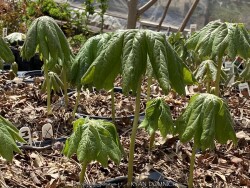
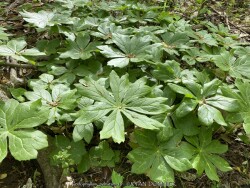
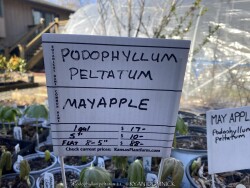

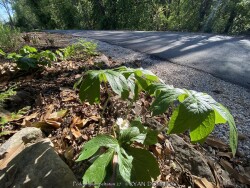

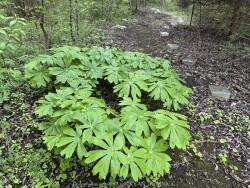
Plant Min Zone: 3a
Plant Max Zone: 8a
Sunlight: Part Sun, Shade
Water / Rainfall: Low, Average
Soil Quality: Average, Rich
Bloom Season: Early Spring, Spring
Flower Color: White
Berry / Fruit Color: Green
Spring Foliage Color: Green
Summer Foliage Color: None: Dormant
Fall Foliage Color: None: Dormant
Evergreen Foliage: No
Winter Interest: No
Scented Flowers: No
Drought Tolerance: Medium, High
Wet-Feet Tolerance: Low
Humidity Tolerance: Medium
Wind Tolerance: Medium
Poor Soil Tolerance: Rocky Soils
Height: 1' - 1.5'
Width: 0.75' - 1'
Growth Rate: Medium
Service Life: Long: 5-10 years
Maintenance Need: Low
Spreading Potential: Low
Yearly Trimming Tips: Trim Perennial to Ground in Late Spring or Summer After Die-back Occurs: Summer Dormant.
Plant Grouping Size: Small Grouping of 3-5, Medium Grouping of 5-10
Best Side of House: East Exposure
Extreme Planting Locations: Resistant to Rabbits
Ornamental Features: Emerges Early in Spring, Easy to Eat Edibles, Exceptional / Colorful Foliage
Special Landscape Uses: Groundcover, Naturalizing
Possible Pest Problems: Weed Competition
Plant Limitations: May be Dormant in Summer, Susceptible to Late Spring Frosts, May be Poisonous
Shippable in 2026: YES
Mayapple (Podophyllum peltatum) is a spring growing perennial with large green umbrella like leaves. White five petal flowers appear on mature plants with green "apple-like" fruits to follow. Mayapple is native to rich woodland areas in Kansas, the Midwest, and most of the eastern United States; it needs rich well-drained soils. Mayapple colonizes by rhizomes forming dense slow-spreading mats making this an easy plant to spot from a distance especially in the early spring. Early spring emergence is normally not a problem as foliage resists normal spring frosts. During the April deep freeze of 2007 in Lawrence, KS, temperatures bottomed out at 18°F after an extra warm March. As a comparison, hosta foliage had completely unfurled was killed to the ground but Mayapple foliage had no damage for several days of the cold blast with temperatures down to 22-24°F! Moderate damage occurred on the last night at 18°F but no long term problems persisted. After summer heat and drought sets in usually by mid June, the foliage disappears completely going dormant until the next spring. Because it goes dormant, summer drought is usually not a problem as long as soil is rich in organic matter and moisture-retentive. Fruit-set is uncommon as vegetative growth is the primary method of propagation. A single-leafed stem will not produce a flower that season. A forked stems bearing two leaves will have a tight flower bud nestled at the base of the two petioles and possible fruit if pollinated. Bees seem to do this work, especially queen bumble bees. Blooms occur at a time of year when other pollen sources are rare thus being very valuable for wild-life. Fruit is sweet and edible, however with caution. Usually one or two fruits is safe but toxic if eaten in larger quantities. Usually, raccoons or possums get to the fruit before humans. This native perennial gives a tropical vibe and is valuable for the early spring foliage, flower, and fruit but be prepared for a bare spot during the rest of summer unless you fill in with summer annuals, late emerging perennials, or mulch to stop weed growth.